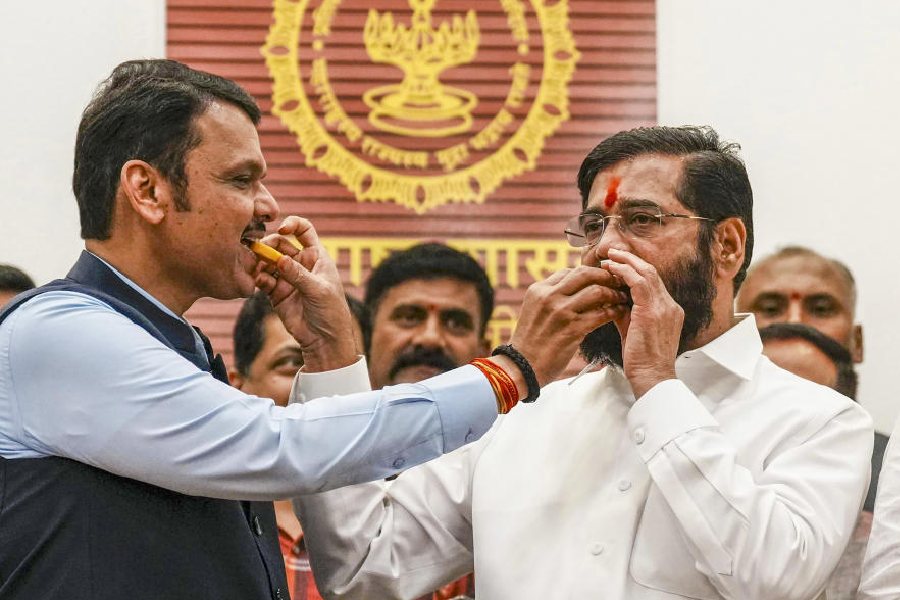 Wednesday, 22 January 2025
Wednesday, 22 January 2025
 Wednesday, 22 January 2025
Wednesday, 22 January 2025
It’s the mother of all U-turns. Andhra Pradesh chief minister N. Chandrababu Naidu has just sent out a blunt message: Have more children!
“Earlier I had pushed for population control. Now I am talking about population promotion,” Naidu told an audience of businessmen.
Naidu is backing this clarion call with a threat to introduce a new law that only people who have more than two children will be eligible to stand for election to the state’s local bodies.
Tamil Nadu chief minister M.K. Stalin has an even more drastic solution to solve the problem of falling fertility rates and not enough children.
He suggested to a group of newlyweds that they should aim for 16 children per couple. However, he didn’t address how these couples would manage such large families — or offer any financial incentives.
With India’s population already at a staggering 1.4 billion, calls for a baby boom may seem outright bizarre. So, what’s suddenly causing concern among southern politicians?
While the nation’s overall population remains enormous, the demographic shift toward aging communities and shrinking young populations in certain regions has pushed politicians to consider radical solutions.
Naidu has long warned of falling birth rates and the rising number of elderly people. The upcoming census and the Delimitation Commission, which will determine how many parliamentary seats each state will receive based on population, have brought these issues to the forefront.
While Uttar Pradesh will see its influence grow, other states with slower population growth may lose seats, particularly in southern India. Worst affected is likely to be Kerala, which is projected to lose one of its current 20 seats in parliament as a result of the new census, while Tamil Nadu may gain just one.
By contrast, the large population growth in Uttar Pradesh, which has over 200 million people, means the state will be a major beneficiary of the delimitation exercise. The state is expected to gain around 11 to 13 seats.
We’ve come a huge distance from the population control slogans plastered on rural walls in earlier decades. First there was “do ya teen bas,” the political rallying cry of the 1970s. That was followed by the even more restrictive “Hum do, hamare do.” Now politicians are backpedalling at high speed.
When it comes to falling population, there’s no doubt that the south Indian peninsula led the way. But the rest of the country isn’t that far behind.
The statistics are quite remarkable, especially for those who grew up in an earlier era when overpopulation was considered easily the country’s greatest failing and one of the biggest obstacles to economic development.
Today, an impressive 31 states and Union Territories have hit what’s called the “replacement fertility rate” of 2.1 births, which is required to maintain a stable population. Only five states – Bihar, Uttar Pradesh, Jharkhand, Meghalaya, and Manipur – still exceed the replacement rate of 2.1.
Leading the way, unsurprisingly, is Bihar, which has a total TFR (total fertility rate) of 3.02 according to the last National Family Health Survey in 2021. That’s far ahead of Uttar Pradesh, the other giant-sized state where the number stands at 2.38. Jharkhand, the third large state, is at 2.31.
There are even more extreme variations within these states. The birth numbers in rural Bihar look like nothing in any other part of the country. For instance, in one district, Kishanganj, the fertility rate hovers around 4.8 or 4.9. Cash incentives for sterilisation and free birth control tablets have failed to make the slightest impact.
In contrast, Andhra Pradesh’s TFR has been steadily falling. In the last NHFS, conducted between 2019-2021, it was 1.7. That’s now plunged further to 1.5. The rapid TFR fall is what has pushed Naidu to press the population alarm bells. “If the population declines any further, we will see a higher number of elderly people in the villages,” he warned.
During his speech to the businessmen in the state, Naidu acknowledged the irony of his new stance. “I was staunchly in favour of population control once upon a time.” He added: “You listened to me and brought down the population of Andhra Pradesh in just 10 years. Now I am afraid we won’t have enough young people in the state.”
Naidu is almost certainly looking at his next-door state. Tamil Nadu’s TFR is one of the lowest in the country at 1.4, matched only by West Bengal, also at 1.4. Calcutta, at 1, has the lowest TFR amongst India’s major metropolitan areas.
Unsurprisingly, the fertility rates are much lower in urban areas like Delhi, for instance. It’s the same in the state capitals. “In a highly urban area like Jaipur, you have low fertility rates. But if you go to Tonk or the interiors, you will find that fertility rates are higher, especially in backward regions,” says Martand Kaushik, a senior specialist at the Population Foundation of India.
Naidu’s smart enough to know that stopping people with small families standing for local elections is not likely to push up birth rates. He promises that incentives are on their way to encourage people to have more children.
Naidu pointed to countries like Japan and others in Europe where populations are shrinking dramatically. Countries like Hungary have brought in a whole string of incentives like interest-free loans for young families, mortgage exemptions, income tax exemptions for mothers of four or more children, and subsidies for home ownership and large family cars.
There has been a slight increase in Hungary’s birth rate—from 1.25 children per woman in 2010 to around 1.55 in 2023. But it still falls short of the replacement rate of 2.1 children, and despite the measures to provide support, Hungary’s 10-million population continues to shrink, with experts predicting it could decrease by as much as 1.5 million by 2050.
Kaushik points out that Naidu will have to offer much more to have the slightest impact.
“Who thinks about whether my country wants more children or fewer children when they are having a child? When people have children, it’s about education and economic opportunity,” Kaushik said. “Parental pressure is another thing. What a politician is saying is not even the hundredth or one-thousandth factor.”
Now that politicians in South India have realised they’re facing a looming political crisis over the plunge in fertility rates, they’re scrambling for ways to avert it. But reversing the trend will be complex, and there are no quick fixes.







